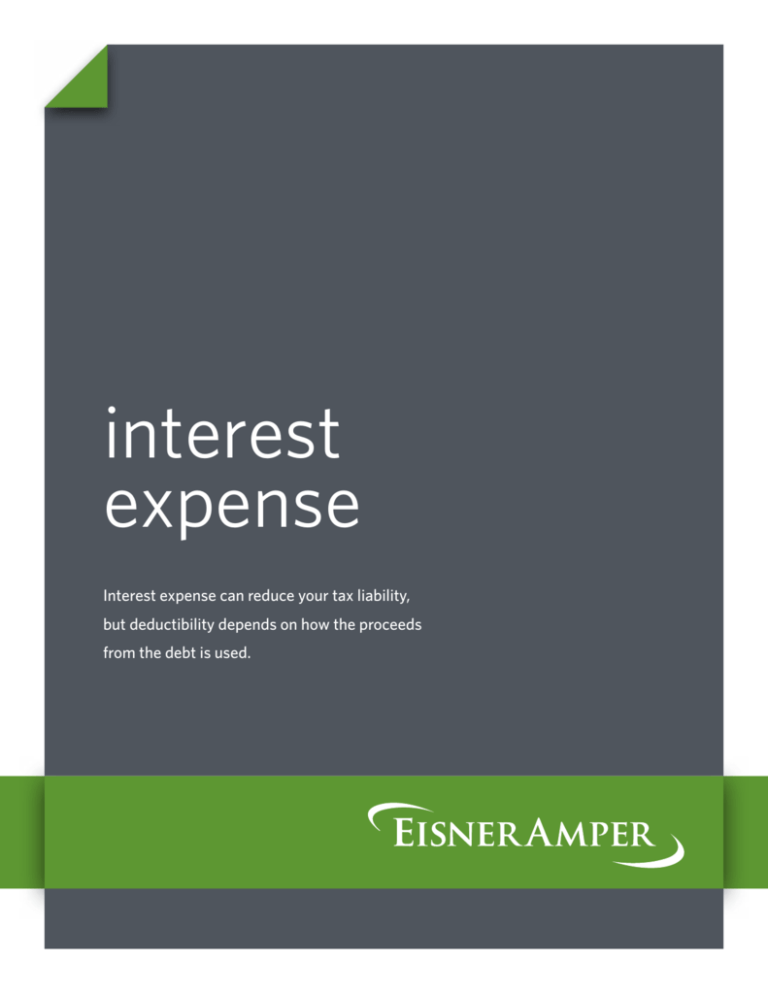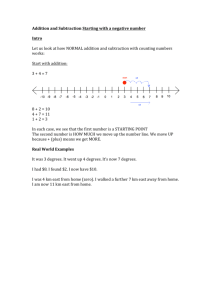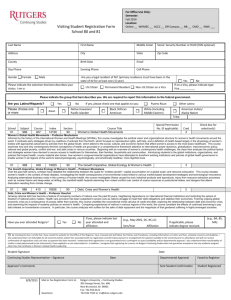interest expense
advertisement

interest expense Interest expense can reduce your tax liability, but deductibility depends on how the proceeds from the debt is used. 63 interest expense INTEREST DEDUCTIBILITY QUALIFIED RESIDENCE Your ability to deduct interest payments is subject to many rules and limitations. Deductibility of interest expense is dependent on how you used the debt proceeds. So, before incurring any new debt, you should consider the options available to you to get the best tax result from the interest you will pay on the debt. Also, periodically review your debt to determine whether you can replace debt generating nondeductible interest expense with other debt so that you can lower your taxes. Interest paid on mortgage debt used to acquire or improve your home is deductible as qualified residence interest, subject to limitations. The two types of qualified mortgage debt are: Acquisition debt. This is debt incurred on the acquisition, construction or substantial improvement of your principal residence and your second home (a so-called vacation home if used for personal purposes). The debt must be secured by the residence and is limited in total to $1 million ($500,000 if married filing separately). Acquisition debt also includes debt from a refinancing of an existing acquisition debt, but only up to the principal of that debt at the time of the refinancing plus any proceeds used to substantially improve your residence. A home equity loan that is used to substantially improve your residence qualifies as acquisition debt. Qualified residence interest does not include interest paid on loans from individuals, such as your parents, if you do not secure the debt with your residence. Once deductible, there are also rules that categorize whether the interest is deductible against your adjusted gross income (“AGI”) (also known as “above the line” deductions) or as an itemized deduction. Generally, interest deducted in computing AGI will yield a better tax result. This difference can especially be significant in reducing your state and local income tax bill. Chart 7 summarizes the nature of the different types of interest deductions. chart 7 interest expense deduction Nature Of Debt Nature of Deduction Not Deductible • • Taxable investments Tax-exempt investments Above-the-Line Deduction • Qualified residence (including a second home) Personal or consumer Itemized Deduction • Trading activities • Business activities • Passive activities • Education loans • Note: Other rules may limit your ability to deduct the interest expense in full. 64 EisnerAmper 2012 personal tax guide Home equity debt. In addition to acquisition debt, you can deduct mortgage interest on a home equity debt (or acquisition debt) up to $100,000 ($50,000 if married filing separately) as long as the debt is secured by a qualified principal residence and does not exceed the equity in your house. Combined with acquisition debt, it allows you to deduct interest on qualifying debt up to $1,100,000. Interest on home equity debt up to $100,000 is deductible as qualified mortgage interest regardless of how you use the proceeds (except if used to purchase tax-exempt bonds). However, the interest is not allowable as a deduction against the alternative minimum tax (“AMT”) since it is not being used to substantially improve your residence, thereby effectively increasing your interest rate if you are in the AMT. PERSONAL OR CONSUMER DEBT Interest expense from personal (or consumer) interest expense is nondeductible. This type of debt includes interest paid on debt used to pay personal expenses, to buy consumer goods (including cars) and to satisfy tax liabilities. The simplest way to convert this nondeductible interest into deductible interest is to take out a home equity loan to pay off your personal debt. Remember, you can use up to $100,000 of home equity debt for any purpose, including paying off personal and credit card debt. In addition to making the interest deductible, you’ll benefit from the generally lower interest rate on this type of debt. If you have already utilized your home equity line, see Tax Tip 20 for a method to convert personal debt into investment debt. Also, if you have interest expense arising from a passive activity that is being limited because you have excess passive losses, consider replacing this debt with home equity debt or investment debt in the same manner as discussed in Tax Tip 20. INVESTMENT INTEREST Investment interest is interest on debt used to buy assets that are held for investment. Margin debt used to buy securities is the most common example of investment debt. Another typical source of investment debt is your pro rata share of investment debt incurred by a pass-through entity (partnership, LLC, or S corporation). The investment interest expense on this debt is treated in the same manner as if you personally paid the interest. Interest on debt used to buy securities that generate tax-exempt income, such as municipal bonds, is not tax-deductible. But be careful, since this rule can reach further than you would expect. As Tax Tip 21 illustrates, you are required to allocate interest expense to the tax-exempt income which makes a portion of the interest expense not deductible. tax tip 20 convert nondeductible debt into deductible margin debt You can reduce or eliminate your personal debt by converting it into deductible margin debt. Rather than using the proceeds from the sale of securities to buy other securities, use the proceeds to pay off your personal debt. You can then use margin debt, to the extent available, to buy new securities. Your total debt and your total stock portfolio remain the same, but you will have converted nondeductible interest into deductible investment interest (assuming no other limitations apply). And the interest rate on margin debt is typically lower than the rate on consumer debt. Caution: Keep loan proceeds totally separate from other funds whenever possible. This can avoid reallocation by the IRS, and may save important tax deductions.. Investment interest expense is only deductible up to the amount of your net investment income. Generally, this includes taxable interest, nonqualifying dividends (as discussed below) and net short-term capital gains (but not net long-term capital gains). Your investment income is reduced by investment expenses (other than interest) directly connected with the production of investment income such as investment advisory fees, but only to the extent they exceed 2% of your AGI. If you are in the AMT, your net investment income will generally be higher because it does not get reduced by investment expenses since you did not receive a tax benefit for these deductions. As a result, your deductible investment interest can be greater for AMT purposes. Any disallowed interest for the regular tax or AMT is carried forward and can be deducted in a later year, to the extent that there is adequate net investment income. Dividend income that is eligible for the 15% preferential tax rate is not treated as investment income for purposes of the investment interest expense limitation. However, dividends that do not qualify for this rate, including dividends received from regulated investment companies — such as money market mutual funds and bonds funds — are still subject to ordinary income tax rates and therefore qualify as investment income. If you have an investment interest expense limitation, an election is available to allow you to treat any portion of your net long-term capital gains and qualifying dividend income as investment income. Generally, this election should only be used if you do not expect to be able to utilize any of the investment interest carryover in the near future. This election can increase the amount of investment interest expense that you can deduct in the current year. By making this election, you lose the favorable lower capital gains and qualified dividend tax rate of 15%, but you get to reduce your taxable income 65 As an example, assume you are subject to the maximum tax rate of 35% and you have $100,000 of investment interest expense in excess of your net investment income. You also have net long-term capital gains of $200,000. By making the election, you pay an extra $20,000 of tax on the capital gains ($100,000 of elected gains taxed at 35% rather than 15%). However, you save $35,000 of tax since your taxable income is lower by the additional investment interest expense ($100,000 at 35%). Therefore, your net tax drops by $15,000. Plus, you will save state taxes if your state of residency allows you to reduce your income by all, or some, of your itemized deductions. ABOVE-THE-LINE DEDUCTIONS Interest expense deductible “above-the-line” against your AGI gives you a greater tax benefit than interest treated as an itemized deduction. This is because the interest expense reduces your AGI, which in turn reduces the 2% phaseout of your miscellaneous itemized deductions, and, if applicable, the limitation on deductible medical expenses and charitable deductions. But even more beneficial for most taxpayers is that the interest will be deductible against your state income, rather than nondeductible if you live in a state that does not allow itemized deductions (such as Connecticut, Pennsylvania and New Jersey), or limited in a state that disallows a portion of your itemized deductions (such as New York). Interest expense eligible for this favorable treatment includes: Trading interest. This is interest incurred on borrowings against taxable securities if you are actively engaged in the business of trading personal property (securities), rather than simply as an investor. This interest commonly passes through a trading partnership or limited liability company (LLC). The interest will be classified as trading interest to you even if you have no involvement in the management of the entity, so long as the entity meets the tests for actively engaging in the business of trading personal property. However, in such a case, the trading interest is still subject to the investment interest expense limitation discussed above. Business interest. This is interest on debt traced to your business expenditures, including debt used to finance the capital requirements of a partnership, S corporation, or LLC involved in a trade or business in which you materially participate. This also includes items that you purchase for your business (as an owner) using your credit card. These purchases are treated as additional loans to the business, subject to tracing rules that allow you to deduct the portion of the finance charges that relate to the business items purchased. Qualified education loans. You can annually deduct up to $2,500 of interest paid on education loans. The availability of the deduction is subject to phase out rules based on adjusted gross income. See chapter on education incentives. PASSIVE ACTIVITY INTEREST EXPENSE Passive interest expense is interest on debt incurred to fund passive activity expenditures, whether paid by you directly or indirectly through the capital requirements of a pass-through business entity. The interest is an additional deduction against the income or loss of the activity, thereby deductible against AGI. However, since the interest expense becomes part of your overall passive activity income or loss, it is subject to the passive activity loss limitations. See the chapter on passive and real estate activities. tax tip 21 INDIRECT TAX-EXEMPT DEBT CAN LIMIT YOUR DEDUCTIBLE INTEREST It is common to have one investment account that holds mostly tax-exempt municipal bonds and a separate account that holds mostly taxable investments (such as stock in publicly traded companies). Assume that you want to use your available margin in the account holding taxable investments to purchase additional stock. Even though you are not using margin in your taxexempt account, your interest deduction will be limited because of an IRS ruling that requires you to allocate a portion of the debt to your tax-exempt holdings based on the ratio of your tax-exempt investments to your total investments. This ruling was designed to prevent a taxpayer from reaping a double tax benefit, and thus treats your accounts as one account and deems you to have indirectly borrowed some of the debt to maintain your tax-exempt account. Therefore, before you borrow against your securities, consider the real after-tax cost of the interest you will be paying. interest expense by the increased investment interest expense you deduct at the higher ordinary income tax rates.







